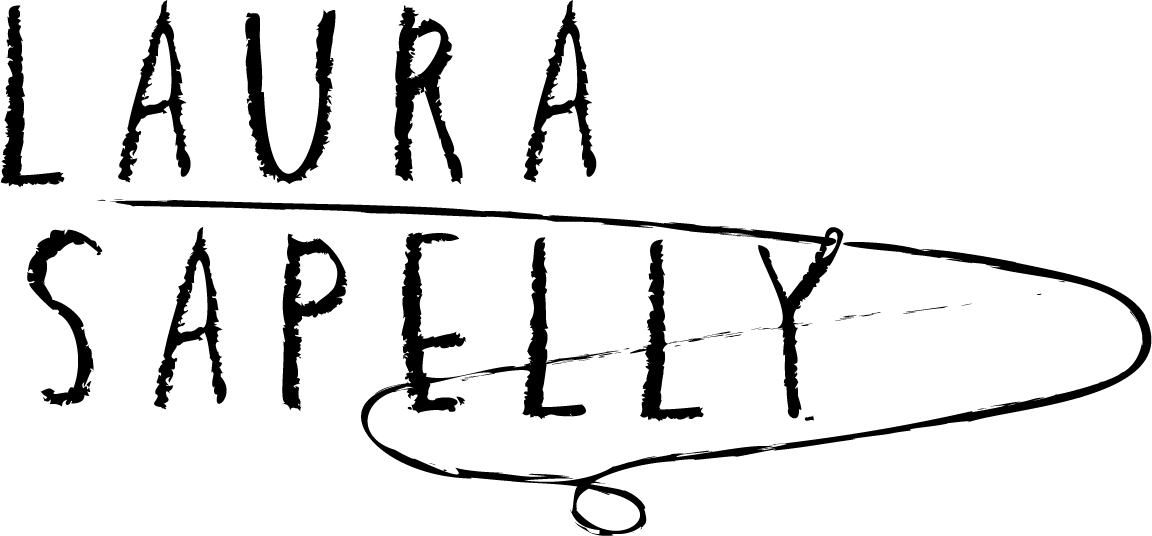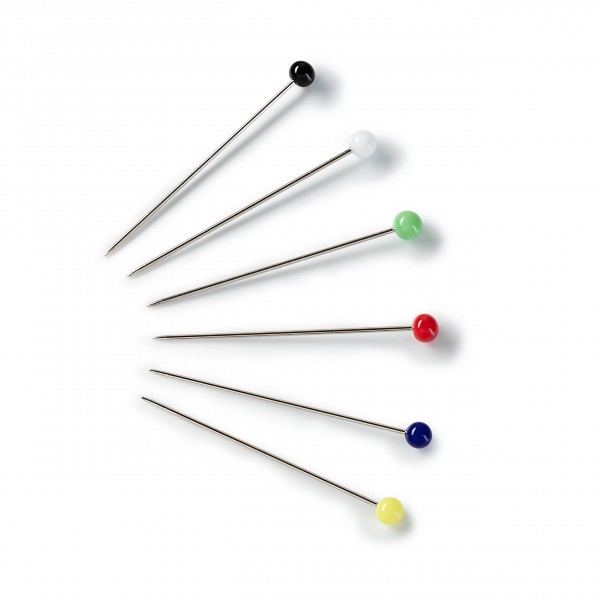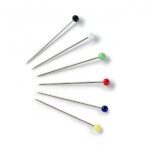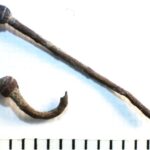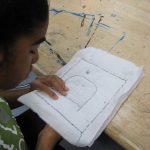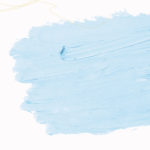Hello there! Get cozy…
Stitchers – whether you’re sitting in your comfy chair with your coffee, in your car, or looking for ENGAGING content teaching in your home or in a school—
we’ve got your stitched stories covered!
Get ready for another fascinating look at an oh so taken for granted tool: the straight pin!
Here’s my straight pin story–What’s yours?
How many pins have I used in my life!? Let me count the thousands! Silk, plastic heads, glass heads, quilting, T-pins, safety pins…..
but today we’re straight-talking about only straight pins!
But if I had a dollar for every pin I’ve used, lost, I’d likely be a millionaire! I find them EVERYWHERE! In beds, on shelves, in shoes(!), I mean, really?
But what would we do without them?
Sure, you can use clips to keep fabrics together.
And some use weights instead of pins to keep their patterns down while the mark and cut them out.
But I love my glass headed pins. Sorry.
And I REALLY came to appreciate them after learning about their history. So difficult to hand-make! To package! And yet so essential and useful…
What is YOUR straight pin story?
Share on our Facebook page or in our private FB group, Storied Sewing Circle ( >>join here!)
What’s this episode really about?
The straight pin has been around for centuries, and guess what? Its function has remained pretty much the same!
Yes, it was used for putting fabric together, but it was also used as an early paper clip.
When I’m without a clip, I’ve been known to reach for one of my lovely glass headed straight pins to bind my papers!!!
What you’ll learn in this episode is that it has a LOT in common with the evolution of
the hand sewing needle (all the details found in Episode 2)…INCLUDING the scary nickel used to produce it.
But you’ll also find out the ORIGINAL use for ….the pincushion! Stop the presses! REALLY!
Join us for this podcast on the fascinating story of straight pins, and you’ll never take yours for granted again!!
Ready for inspo? Workspace love…
This quote and others that I’ll use for this year at least are from this really cool book –
In the company of women: inspiration and advice from over 100 makers, artists, and entrepreneurs. Get it >>>here
It’s by Grace Bonney – who once ran the design sponge blog site.
Unfortunately, I discovered this blog site too late and it had already closed and she had moved on.
However, this book draws upon the women she met in the process of running that blog!
So get inspired and get your “stitch” groove on!
This episode’s quote is from Danielle Colding, an interior designer based in Brooklyn.
In answer to the question,
What is your favorite thing about your workspace? she answered:
“The art. There is an incredible Sol LeWitt mural on one wall and a gallery of some of my favorite fashion and inspiration pictures on the other.
It definitely is a “ more is more” space, and it feels good to be in it.
And now I share it with my husband, so it has become the real center of our home. It’s his favorite room in the house too.”
Many of the women featured in this book have home studios and I can certainly relate
as I have transformed my own living space into a live workplace without focusing all the time on the work!
I finally got to the point where I can merge the two without constantly being pulled into one of the other!
So, What is your favorite thing about your workspace?
Whether you’re at home or in a hybrid office situation. share on your social media page and link to us!
Episode #5: Straight pins have been around since…
Ok, so pins have existed since the Paleolithic era! Yes, THAT old! Materials used to make them were bone and thorn. The Celts and Ancient Romans used them, too! Neolithic sites are rich in Wooden pins, dated to the Neolithic era (10,000 BC), were still in use during Elizabeth I reign 1558-1603)!
That’s a long run for wooden pins, which must have been awful, catching on everything…Seriously…
The Bronze Age brought metal pins, found in Asia, North Africa, and Europe…But where were these metal pins for thousands of years? Well, they were difficult to make and hence super expensive…
The process had roughly 18 separate steps to produce a small pin. Pins were handmade one at a time. “pin maker’s peg” or the “Pinner’s bone” helped sharpen the pin. Made from a grooved, small thin animal bone to keep the pin straight during sharpening.
But the biggest headache for pin makers was creating the head: Another piece of wire, coiled around the body of the pin, would create the pinhead (ha!), but naturally, it caught on whatever one was pinning together!! It was impossible to create standard pin/head sizes.
And, as in the hand needle, a pinners guild, formed in London in 1356 attempted to have a monopoly over the job and manufacture…. but, in good old competitive parlance, allegedly it was the French who excelled at pin-making.
You’ll be surprised at how LONG it took to perfect the straight pin’s design and mass manufacture!
And, yes, it was Howe- not related to Elias Howe, sewing machine inventor, who got it all “straight.”
Hey hey! References for educators and….. nerds!
Beaudry, Mary Carolyn. Findings: The Material Culture of Needlework and Sewing. New Haven, CT: Yale University Press, 2006.
Leslie, Catherine Amoroso. Needlework Through History: An Encyclopedia. Westport, CT: Greenwood, 2007.
Snodgrass, M. E. (2014). Needle and Thread. In World Clothing and Fashion: An Encyclopedia of History, Culture, and Social Influence (pp. 468-470). Sharpe Reference. https://link.gale.com/apps/doc/CX7037600211/GVRL?u=psucic&sid=GVRL&xid=8ee3b460
Wild, John Peter. Textiles in Archaeology. Risborough, UK: Shire, 2003.
Image and other content sources here
[This post may contain referral-affiliate links. If a purchase is made, I may receive a small commission at no extra cost to you.]
___________________________________
So, why the School of Storied Stitching?
For me, needlework is a deeply meaningful form of personal expression that I want to share.
The sewing circle is a way to connect with fellow stitchers – and to remember those who are gone…
